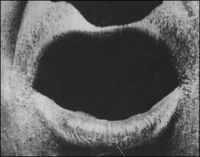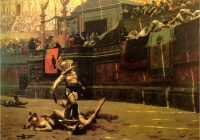Communication
From The Art and Popular Culture Encyclopedia
| Revision as of 15:53, 24 March 2013 Jahsonic (Talk | contribs) ← Previous diff |
Revision as of 13:24, 12 June 2018 Jahsonic (Talk | contribs) Next diff → |
||
| Line 1: | Line 1: | ||
| + | [[Image:From Contes by Octave Uzanne.jpg|thumb|left|200px|[[Loisirs Littéraires au XXe siècle]] (English: "Literary leasures in the 20th century"), an illustration from the story "[[The End of Books]]" by French writer [[Octave Uzanne]] and illustrator [[Albert Robida]].]] | ||
| + | {| class="toccolours" style="float: left; margin-left: 1em; margin-right: 2em; font-size: 85%; background:#c6dbf7; color:black; width:30em; max-width: 40%;" cellspacing="5" | ||
| + | | style="text-align: left;" | | ||
| + | "If, as it appears to me, a book is [[communication]], the [[author]] is only one link in a unity of different [[Reading (process) |reading]]s." --[[Georges Bataille]] from his essay "[[On Nietzsche|Sur Nietzsche]]". --tr. unidentified | ||
| + | |} | ||
| [[Image:The Big Swallow.jpg|thumb|right|200px|This page '''{{PAGENAME}}''' is part of the [[linguistics]] series.<br> | [[Image:The Big Swallow.jpg|thumb|right|200px|This page '''{{PAGENAME}}''' is part of the [[linguistics]] series.<br> | ||
| <small>Illustration: a close-up of a [[mouth]] in the film ''[[The Big Swallow]]'' (1901)</small>]] | <small>Illustration: a close-up of a [[mouth]] in the film ''[[The Big Swallow]]'' (1901)</small>]] | ||
| - | [[Image:Jean-Leon Gerome Pollice Verso.jpg|thumb|right|200px|''[[Pollice Verso]]'' by Jean-Léon Gérôme, 1872, is the immediate source of the "[[thumbs down]]" [[gesture]] in [[popular culture]]. It is owned by [[Phoenix Art Museum]].]] | + | [[Image:Jean-Leon Gerome Pollice Verso.jpg|thumb|right|200px|''[[Pollice Verso (Gérôme)|Pollice Verso]]'' (1872) by Jean-Léon Gérôme]] |
| [[Image:Silk Road.jpg|thumb|200px|The [[Silk Road]], [[Silk Road transmission of art|transmitter]] of [[Western culture]]]] | [[Image:Silk Road.jpg|thumb|200px|The [[Silk Road]], [[Silk Road transmission of art|transmitter]] of [[Western culture]]]] | ||
| [[Image:Awful conflagration of the steam boat Lexington.jpg|thumb|200px|''Awful conflagration of the steam boat Lexington in Long Island Sound on Monday eveg., [[January 13]]th [[1840]], by which melancholy occurence; over 100 persons perished''. Courier [[lithograph]] [[documenting]] a [[news event]], published three days after the [[disaster]].]] | [[Image:Awful conflagration of the steam boat Lexington.jpg|thumb|200px|''Awful conflagration of the steam boat Lexington in Long Island Sound on Monday eveg., [[January 13]]th [[1840]], by which melancholy occurence; over 100 persons perished''. Courier [[lithograph]] [[documenting]] a [[news event]], published three days after the [[disaster]].]] | ||
| {{Template}} | {{Template}} | ||
| - | :''[[visual communication]]'' | ||
| '''Communication''' is a process that allows beings - in particular [[human]]s - to [[exchange]] [[information]] by one of several methods. Communication requires that some kinds of [[symbol]]s from a kind of [[language]] are exchanged. There are auditory means, such as speaking or singing, and [[nonverbal communication|nonverbal]], physical means, such as [[body language]], [[sign language]], [[paralanguage]], [[haptics|touch]] or [[eye contact]]. | '''Communication''' is a process that allows beings - in particular [[human]]s - to [[exchange]] [[information]] by one of several methods. Communication requires that some kinds of [[symbol]]s from a kind of [[language]] are exchanged. There are auditory means, such as speaking or singing, and [[nonverbal communication|nonverbal]], physical means, such as [[body language]], [[sign language]], [[paralanguage]], [[haptics|touch]] or [[eye contact]]. | ||
| Line 22: | Line 26: | ||
| Depending on the focus (who, what, in which form, to whom, to which effect), there exist various classifications. Some of those systematical questions are elaborated in [[Communication theory]]. | Depending on the focus (who, what, in which form, to whom, to which effect), there exist various classifications. Some of those systematical questions are elaborated in [[Communication theory]]. | ||
| ==See also== | ==See also== | ||
| + | :''[[visual communication]]'' | ||
| *[[Animal communication]] | *[[Animal communication]] | ||
| *[[Plant to plant communication]] | *[[Plant to plant communication]] | ||
Revision as of 13:24, 12 June 2018

|
"If, as it appears to me, a book is communication, the author is only one link in a unity of different readings." --Georges Bataille from his essay "Sur Nietzsche". --tr. unidentified |

Illustration: a close-up of a mouth in the film The Big Swallow (1901)


|
Related e |
|
Featured: |
Communication is a process that allows beings - in particular humans - to exchange information by one of several methods. Communication requires that some kinds of symbols from a kind of language are exchanged. There are auditory means, such as speaking or singing, and nonverbal, physical means, such as body language, sign language, paralanguage, touch or eye contact.
Communication happens at many levels (even for one single action), in many different ways, and for all beings, and some machines. Many or all, fields of study dedicate some attention to communication, so when speaking about communication it is very important to be sure about what aspect of communication one is speaking about. Some definitions are broad, recognizing that animals can communicate with each other as well as human beings, and some are more narrow, only including human beings within the parameters of human symbolic interaction.
Nonetheless, communication is usually described along a few major dimensions:
- Content (what type of things are communicated)
- Source (by whom)
- Form (in which form)
- Channel (through which medium)
- Destination/Receiver (to whom)
- Purpose/Pragmatic aspect (with what kind of results)
Between parties, communication content include acts that declare knowledge and experiences, give advice and commands, and ask questions. These acts may take many forms, including all variations of nonverbal communication. The form depends on the symbol systems used. Together, communication content and form make messages that are sent towards a destination. The target can be oneself, another person (in interpersonal communication), or another entity (such as a corporation or group).
Depending on the focus (who, what, in which form, to whom, to which effect), there exist various classifications. Some of those systematical questions are elaborated in Communication theory.
See also
- Animal communication
- Plant to plant communication
- Cross-cultural communication
- Telecommunication
- Telepathy


